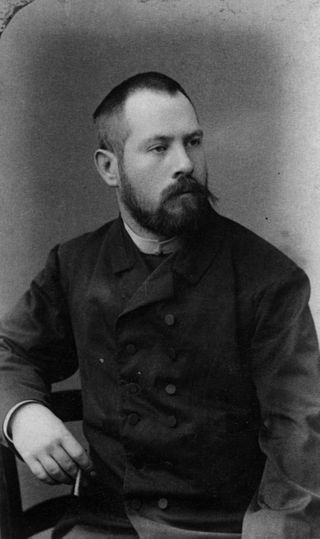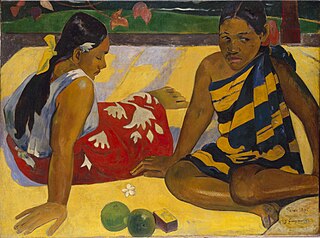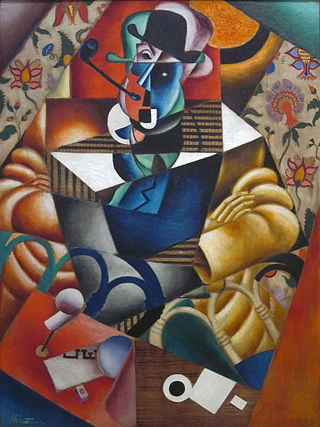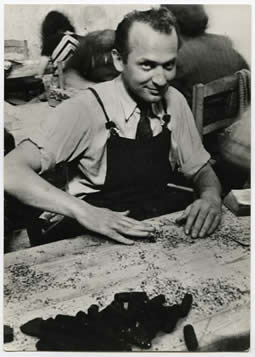Jesper Knudsen (born 1964) is a Danish painter. Knudsen's paintings have been compared to street art because they appear very spontaneously made. While painting, Knudsen turns the canvas around several times. Strange animals, patterns, faces, bodies, parts of bodies are painted in strong colours in several layers covering part of each other. In the early works the motifs were often accompanied by small texts and words. The medium is oil or acrylic on canvas, but graphic works have also been part of Knudsen's production so far.
Galerie Moderne. ”Jesper Knudsen”, 2006 27 sider illustreret i farver. Foto: Ralf Sørensen. Parallelle tekster på dansk og engelsk.

Robert Delaunay was a French artist who, with his wife Sonia Delaunay and others, co-founded the Orphism art movement, noted for its use of strong colours and geometric shapes. His later works were more abstract. His key influence related to bold use of colour and a clear love of experimentation with both depth and tone.

Lovis Corinth was a German artist and writer whose mature work as a painter and printmaker realized a synthesis of impressionism and expressionism.

Günther Förg was a German painter, graphic designer, sculptor and photographer. His abstract style was influenced by American abstract painting.
Antonio SauraAtarés was a Spanish artist and writer, one of the major post-war painters to emerge in Spain in the fifties whose work has marked several generations of artists and whose critical voice is often remembered.
Albert Oehlen is a German artist. He lives and works in Bühler, Switzerland and Segovia, Spain.
Andrei Kolkoutine is a Russian artist. In 1982 Kolkoutine graduated at the Repin Academy of Arts in Leningrad, named after Ilya Repin. Currently Kolkoutine lives in southern Russia in the town of Nalchik. He belongs to the art group " FOSTER BROTHERS " together with two other famous artists - Andrey Efi and Eugeny Lindin. The medium of his paintings is usually oil on canvas, but Kolkoutine also made a few sculptures and graphic works. Besides Russia, Kolkoutine has made exhibitions in Denmark, Germany, France and other European countries as well as the United States.

The Galerie Neue Meister in Dresden, Germany, displays around 300 paintings from the 19th century until today, including works from Otto Dix, Edgar Degas, Vincent van Gogh and Claude Monet. The gallery also exhibits a number of sculptures from the Dresden Sculpture Collection from the same period. The museum's collection grew out of the Old Masters Gallery, for which contemporary works were increasingly purchased after 1843.

Yellow and Green Brushstrokes is a 1966 oil and Magna on canvas pop art painting by Roy Lichtenstein. It is part of the Brushstrokes series of artworks that includes several paintings and sculptures. It is located at the Museum für Moderne Kunst in Frankfurt, Germany. As with all of his Brushstrokes works, it is in part a satirical response to the gestural painting of Abstract Expressionism. It is in the collection of the Museum für Moderne Kunst.

Les Baigneuses is a large oil painting created at the outset of 1912 by the French artist, theorist and writer Albert Gleizes (1881–1953). It was exhibited at the Salon des Indépendants in Paris during the spring of 1912; the Salon de la Société Normande de Peinture Moderne, Rouen, summer 1912; and the Salon de la Section d'Or, autumn 1912. The painting was reproduced in Du "Cubisme", written by Albert Gleizes and Jean Metzinger the same year: the first and only manifesto on Cubism. Les Baigneuses, while still 'readable' in the figurative or representational sense, exemplifies the mobile, dynamic fragmentation of form and multiple perspective characteristic of Cubism at the outset of 1912. Highly sophisticated, both in theory and in practice, this aspect of simultaneity would soon become identified with the practices of the Section d'Or group. Gleizes deploys these techniques in "a radical, personal and coherent manner". Purchased in 1937, the painting is exhibited in the permanent collection of the Musée d'Art Moderne de la Ville de Paris.

Let's Get Lost is a 1997 Danish film written and directed by Jonas Elmer and produced by Per Holst. The film is an improvisational slice-of-life comedy shot in black and white. The film earned the 1998 Bodil Award for Best Danish Film and shared the Robert Award for Best Danish Film with Barbara.

En Canot is a Cubist oil painting created by Jean Metzinger in 1913. The work is referred to in various publications as Femme à l'ombrelle, Im Boot, Le Canot, En Bâteau, In the Canoe, The Boat, On the Beach, Am Strand, Im Schiff, V Člunu and Im Kanu. The painting was exhibited in Paris at the 1913 Salon d'Automne. The following year it was shown at Moderní umění, 45th Exhibition of SVU Mánes in Prague, February–March 1914. This "Survey of Modern Art" was one of the last prewar exhibitions in Prague. En Canot was exhibited again, in July of the same year, at the Galerie Der Sturm, Berlin. The painting was acquired from Herwarth Walden in 1916 by Georg Muche at Galerie Der Sturm.

Léonce Rosenberg was an art collector, writer, publisher, and one of the most influential French art dealers of the 20th century. His greatest impact was as a supporter and promoter of the cubists, especially during World War I and in the years immediately after.

Georges Valmier was a French painter. His work encompassed the great movements in the modern history of painting, starting with Impressionism in his early years, then Cubism which he discovered when he was around 25 years old, and finally Absstractionism from 1921. He also designed sets and costumes for theater and ballet, and models for fabrics, carpets, and other objects. His oil paintings do not exceed 300 in number, since Valmier died prematurely at the age of 51. His paintings were the culmination of many preparatory drafts in gouaches, multiple versions of which are works in themselves and reflect his penchant for colors and inventive shapes. Valmier was also a musician. He performed the works of Debussy, Ravel, Fauré, and Satie at major concerts and in churches, and had a decisive influence on the career of André Jolivet.

Le Fumeur, or Man with Pipe, is a Cubist painting by the French artist Jean Metzinger. It has been suggested that the sitter depicted in the painting represents either Guillaume Apollinaire or Max Jacob. The work was exhibited in the spring of 1914 at the Salon des Indépendants, Paris, Champ-de-Mars, March 1–April 30, 1914, no. 2289, Room 11. A photograph of Le Fumeur was published in Le Petit Comtois, 13 March 1914, for the occasion of the exhibition. In July 1914 the painting was exhibited in Berlin at Herwarth Walden’s Galerie Der Sturm, with works by Albert Gleizes, Raymond Duchamp-Villon and Jacques Villon.

Soldier at a Game of Chess, is a painting by the French artist Jean Metzinger. While serving as a medical orderly during World War I in Sainte-Menehould, France, Metzinger bore witness to the ravages of war firsthand. Rather than depicting such horrors, Metzinger chose to represent a poilu sitting at a game of chess, smoking a cigarette. The military subject of this painting is possibly a self-portrait.

Crystal Cubism is a distilled form of Cubism consistent with a shift, between 1915 and 1916, towards a strong emphasis on flat surface activity and large overlapping geometric planes. The primacy of the underlying geometric structure, rooted in the abstract, controls practically all of the elements of the artwork.
Woman Ironing is a 1904 oil painting by Pablo Picasso that was completed during the artist's Blue Period (1901—1904). This evocative image, painted in neutral tones of blue and gray, depicts an emaciated woman with hollowed eyes, sunken cheeks, and bent form, as she presses down on an iron with all her will. A recurrent subject matter for Picasso during this time is the desolation of social outsiders. This painting, as the rest of his works of the Blue Period, is inspired by his life in Spain but was painted in Paris.

Judit Reigl was a Hungarian painter who lived in France.

Jacques Hérold was a prominent surrealist painter born in Piatra Neamț, Romania.

Richard Schur is a German artist.